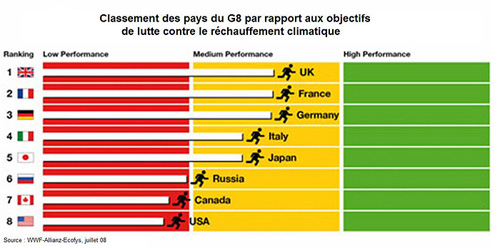 |
||||||
|
|
||||||
|
Native people wish to be recognized for their contribution in slowing down climate change
In hardly a few years, the reduction in the emission of greenhouse gases has become a major concern for the international community, which is now well aware that global warming ensuing from this will have dramatic socio-economic repercussions for the planet. The main cause for carbon dispersion in the atmosphere, the combustion of fossil fuels is the first factor on which we can act. This was concretized by a series of measures aiming to reduce our energy consumption (energy efficiency, reduction of our ecological footprint) while encouraging people to resort to renewable energies. Nevertheless, these decisions proved to be insufficient in a global context of demographic and economic growth, each time more energy-consuming while destroying more natural species. The logical consequence of this situation, deforestation essentially concentrated in the tropical area (Amazon, Central Africa and Malaysia/ Indonesia) has become the second cause for global warming, that is, 20-25% of the global emissions of CO2. Faced with this rather urgent problem, the rich countries and the countries of the South have been blaming each other for more than ten years now. In the North, they consider that the developing countries must also make efforts and quickly take concrete measures. In the South, they put forward that the rich countries must not compromise the development of the poor countries and hence must generously finance the fight against climate change for which historically they are primarily responsible… During these years, in order to overcome these oppositions, but particularly to avoid paying the environment bill, they backed measures aiming to gradually direct the market economy towards more ecological options. Thus were born the Mécanismes de Développement Propres (MDP) (Clean Development Mechanisms) and a very dynamic carbon free market. In fact, the results are quite disappointing, and even catastrophic: They have perniciously resulted in the disappearance of ancient forests to make way for oil palm plantations! But above all, deforestation has increased …
At the Bali Conference in late 2007, a possible new mechanism was put forward: “avoided deforestation” which still involved heated discussions to hopefully establish this more effective mechanism: The REDD (Reduction of Emissions from Deforestation and Degradation of forests). This is based on an obvious but long neglected precept: “Before re-afforesting, deforestation must be slowed down”. There is no dearth of arguments. First of all, a tropical forest holds two to three times more carbon than a plantation. Hence it is necessary to protect these stocks and to do everything in order not to release them in the atmosphere. A new development: scientists have shown that the carbon balance of mature tropical forest, i.e. balanced, is not neutral as had been thought for 40 years, but positive: They store on an average each year 1 ton of carbon per hectare which is a total of 2 billion tons of carbon per year, representing at least 10% of the sequestration capacity of carbon on earth. Let us recall other arguments: more generous this time, i.e.: the biodiversity of tropical forests, a source of wealth, their role in the water cycle, the moisture retention on the equatorial belt and its defining role in the stability of large currents and global climate, their socio-economic importance for more than a billion and half people living in the direct vicinity. If everyone agrees to stop deforestation, it is how to tackle the issue that is the problem. All the NGO environmentalists are sounding the alarm to remind that it is urgent to act, that the Amazon could disappear by 2070 if nothing is done, and even for the most pessimistic, could enter an irreversible process of savannization or desertification, as early as 2040! More importantly, they express serious doubts about leaving the last of primary forests at the mercy of the Carbon Exchange market whose fragility came to light in September 2008… They chose to advocate for the creation of an international fund against deforestation fuelled by a carbon tax on transport. As an echo, Brazil, Ecuador and other countries have indicated their readiness to embark on a “Zero Deforestation by 2050” objective, if the international community comes together to mobilize funds for them… What amount of money are we talking about? The World Bank estimates the cost of avoided deforestation at 25 USD/hectare/year, which is still a tidy sum of 100 billion dollars / year, equivalent to the official financial support for global development for the year 2005! Until the time when part of these funds are voted (perhaps in Copenhagen late 2009) the discussions will focus on the most suitable manner to finance locally how to curb the irrational exploitation of the forests leading to their destruction. The pressure is such on the deforestation front that it will be very difficult “to prevent a poor person from cutting the only resource he has to eat” as stated by the Brazilian President Lula de Silva ... The focus of all concerns is: In practice, how will we be able to reverse the trend when facing a group of peasants without lands living below the poverty line ? There is concern that the native people are kept away from the aids which will come as a priority on the colonization front, giving up the large extensions of forests which they have managed to preserve for thousands of years. The example is given to us by Ecuador, which just launched in late 2008 the Sociobosque, an innovative programme of “Social Forestry Reserves”, to be financed by REDD, which proposes to pay the land owners up to 30 USD/year/hectare if they undertake to conserve their forest intact. Already the government announced that it would consider only 10% maximum of native lands and up to only 3 USD/year/hectare… The case of Ecuador’s Shiwiar Indians is exemplary in this regard: 1,200 Indians who own 210,000 hectares of primary forests and whose standard of living is way below the regional average. They only receive 63,000 USD/year (if they are selected!) which is hardly 52 dollars per capita per year, whereas the owners of small 20 hectare plots of forestlands could receive 600 USD/year of compensation, which is 50% of their revenues, an amount insufficient to guarantee the actual conservation of these pieces of forests, lost amidst farmlands. In fact, the total economy of the 1200 Shiwiar Indians is estimated at 410,000 USD/year including all the government aids in various forms and all the development assistance projects on their land, i.e. 2 USD/hectare/year, a figure ten times less than the cost of avoided deforestation previously mentioned. In this precise case and unlike what is being done, it would be possible to subsidize an ancient forest, as big as the entire Paris area at a lower cost, while ensuring an adequate income to its native inhabitants. It remains that the current deforestation criteria are considered in relation to the colonization front and not to the deep forest, which penalizes the Indians. Let us mention other examples from the carbon offsetting managed by the market economy which discriminates against the native people. Additionality
A project is additional if it could be executed only with the financing from the sale of emission reductions it generates. All the populations who managed to maintain a sustainable relation with their environment are disqualified straightaway*. The aids are therefore for the most deteriorated, already deforested areas, and particularly for reforestation which produces a larger storage of carbon in the short-term…
Permanence
The carbon savings must be ensured for 100 years. The aids are provided for easy-to-implement projects like for instance the installation of heating and cooking appliances using renewable energies which moreover drive the economy…
Reductions of quantifiable CO2 quantifiables
The project must have a clearly quantified carbon savings: all remote, difficult to access, little known, vast or less researched areas are degraded, whereas they are precisely the richest in biodiversity...
Absence of leaks
A project during its execution must not generate “collateral” carbon emissions. Projects in national parks, without population, are preferred…
It is situations like these which make the native people particularly distrustful when programs managed by the State, otherwise undermined by corruption, are set up on their territories. They know from experience that the aids never reach them, that they are seldom consulted or that during the creation of natural reserves some ethnic groups were at times displaced or most often expropriated, sometimes being the victims of environmental policies. The plight of forest people is ignored to such an extent that history is likely to be repeated. "We wish to exercise our right to decide the future of the tropical forests. The forest people who do not deforest must receive their share of profits from international funds or from carbon credits." This is essentially what 650 native representatives from five continents reaffirmed in the Manaus Declaration in April 2008. In 2006, they had already stood against the environmental services and the stock exchange dealings « which made money in the cities while continuing to pollute the planet ». They are determined to make their voices heard and to be finally recognized for their active and decisive role in slowing down climate change. This recognition is through the return of their ancestral lands in the form of land titles when it is still possible, but also through the possibility to manage their forests, according to their traditional view of nature (or cosmic vision), since it is an established fact that the rate of deforestation is 17 times lower in the native lands than in the rest of the Amazon region in Brazil. At this time when “the house is burning”, the native forests must not be forgotten in the REDD mechanisms for avoided deforestation, since they still embody the principles of life of a truly sustainable humanity…They are not a carbon mass or lines of trees quietly waiting for modern man to come and reduce his ecological footprint with great difficulty. They are live and interactive partners of men and women who know the virtues of humility and sobriety. © Jean-Patrick Costa, 2009 arutam@free.fr
*
In the case of the Shiwiar Indians of Ecuador, their territory holds 137 MTC, which is more than all carbon emissions of France in a year. Moreover, their 210,000 hectares of mature primary forest stores 210,000 TC annually, the carbon ton having an average value of 20 € on the stock market. Out of the four mandatory criteria for carbon offsetting, only additionality is not fulfilled: They cannot hence qualify for any aid and are not recognized for their contribution to slowing down the climate change.
These aids go to the peripheral regions of the forests rather than to their centres, making them vulnerable to pressure from deforestation or exploitation. The new REDD system must be able to take this factor into account, if it is to be effective. In fact, the vast majority of Amazonian native territories could be effectively protected with a subsidy of only 2 USD/hectare/year, i.e., for a cost of a ton of stored carbon ten times lesser than the market… |
|
|||||
|
||||||


